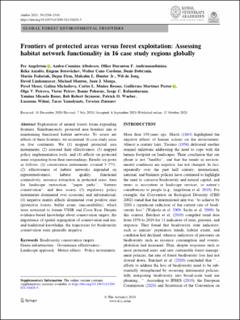Frontiers of protected areas versus forest exploitation: Assessing habitat network functionality in 16 case study regions globally
| dc.contributor.author | Angelstam, Per Krister | |
| dc.contributor.author | Albulescu, Andra-Cosmina | |
| dc.contributor.author | Andrianambinina, Ollier Duranton F. | |
| dc.contributor.author | Aszalós, Réka | |
| dc.contributor.author | Borovichev, Eugene | |
| dc.contributor.author | Cardona, Walter Cano | |
| dc.contributor.author | Dobrynin, Denis | |
| dc.contributor.author | Fedoriak, Mariia | |
| dc.contributor.author | Firm, Dejan | |
| dc.contributor.author | Hunter, Malcolm L. | |
| dc.contributor.author | de Jong, Wil | |
| dc.contributor.author | Lindenmayer, David | |
| dc.contributor.author | Manton, Michael | |
| dc.contributor.author | Monge, Juan J. | |
| dc.contributor.author | Mezei, Pavel | |
| dc.contributor.author | Michailova, Galina | |
| dc.contributor.author | Brenes, Carlos L. Muñoz | |
| dc.contributor.author | Petrova, Olga V. | |
| dc.contributor.author | Pastur, Guillermo Martínez | |
| dc.contributor.author | Petrov, Victor | |
| dc.contributor.author | Pokorny, Benny | |
| dc.contributor.author | Rafanoharana, Serge C. | |
| dc.contributor.author | Rosas, Yamina Micaela | |
| dc.contributor.author | Seymour, Bob Robert | |
| dc.contributor.author | Waeber, Patrick O. | |
| dc.contributor.author | Wilmé, Lucienne | |
| dc.contributor.author | Yamelynets, Taras | |
| dc.contributor.author | Zlatanov, Tzvetan | |
| dc.date.accessioned | 2022-06-21T11:08:35Z | |
| dc.date.available | 2022-06-21T11:08:35Z | |
| dc.date.created | 2021-12-03T15:04:33Z | |
| dc.date.issued | 2021 | |
| dc.identifier.citation | Ambio. 2021, 50 (12), 2286-2310. | en_US |
| dc.identifier.issn | 0044-7447 | |
| dc.identifier.uri | https://hdl.handle.net/11250/2999804 | |
| dc.description.abstract | Exploitation of natural forests forms expanding frontiers. Simultaneously, protected area frontiers aim at maintaining functional habitat networks. To assess net effects of these frontiers, we examined 16 case study areas on five continents. We (1) mapped protected area instruments, (2) assessed their effectiveness, (3) mapped policy implementation tools, and (4) effects on protected areas originating from their surroundings. Results are given as follows: (1) conservation instruments covered 3–77%, (2) effectiveness of habitat networks depended on representativeness, habitat quality, functional connectivity, resource extraction in protected areas, time for landscape restoration, ‘‘paper parks’’, ‘‘fortress conservation’’, and data access, (3) regulatory policy instruments dominated over economic and informational, (4) negative matrix effects dominated over positive ones (protective forests, buffer zones, inaccessibility), which were restricted to former USSR and Costa Rica. Despite evidence-based knowledge about conservation targets, the importance of spatial segregation of conservation and use, and traditional knowledge, the trajectories for biodiversity conservation were generally negative. | en_US |
| dc.language.iso | eng | en_US |
| dc.rights | Navngivelse 4.0 Internasjonal | * |
| dc.rights.uri | http://creativecommons.org/licenses/by/4.0/deed.no | * |
| dc.subject | Biodiversity conservation targets | en_US |
| dc.subject | Green infrastructure | en_US |
| dc.subject | Governance effectiveness | en_US |
| dc.subject | Landscape approach | en_US |
| dc.subject | Matrix effects | en_US |
| dc.subject | Policy instruments | en_US |
| dc.title | Frontiers of protected areas versus forest exploitation: Assessing habitat network functionality in 16 case study regions globally | en_US |
| dc.type | Peer reviewed | en_US |
| dc.type | Journal article | en_US |
| dc.description.version | publishedVersion | en_US |
| dc.source.pagenumber | 2286-2310 | en_US |
| dc.source.volume | 50 | en_US |
| dc.source.journal | Ambio | en_US |
| dc.source.issue | 12 | en_US |
| dc.identifier.doi | 10.1007/s13280-021-01628-5 | |
| dc.identifier.cristin | 1964512 | |
| cristin.ispublished | true | |
| cristin.fulltext | original | |
| cristin.qualitycode | 1 |

